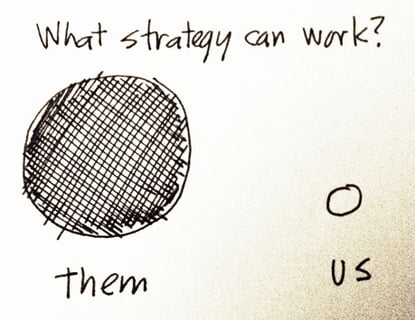The movie Moneyball, nominated for six Academy Awards, depicts how Billy Beane, general manager for the Oakland A's, re-imagined how to think about the dynamics of assembling a major league baseball team. With limited money and a newly innovative reliance on analytics, the A's story features plenty of rich innovation strategy lessons throughout the movie.
Here are eight innovation strategy lessons within Moneyball and the story of how the Oakland A’s applied a statistically-oriented, sabermetrics approach to baseball strategy and improved performance against much richer teams in the early 2000s.
1. Take advantage of having inferior resources and employ a dramatically different innovation strategy.
The Oakland A’s were faced with a major salary constraint compared to other teams able to spend much more on widely regarded superstar baseball players. As Oscar-nominated Brad Pitt (who played Billy Beane) puts it, “There are rich teams and poor teams, then 50 feet of crap. Then there’s us.” When you have inferior resources, look at your situation in new ways to develop an innovation strategy. That innovation strategy likely includes changing the rules of the game you’re playing.
2. When your market situation changes, you can’t think with dated conventional wisdom.
Baseball scouts are characterized in the movie as employing 150-year old guidelines to evaluate baseball talent. Granted, some of the conventional wisdom seems pretty perceptive (i.e., “An ugly girlfriend means no confidence.”) Billy Beane brings his scouting staff up short, however, telling them bluntly that talking like business as usual wouldn’t work. The old rules were making for an unfair game and demanded different thinking. In Billy Beane’s case with the Oakland A’s, the different thinking meant fully embracing a Bill James sabermetrics approach to new baseball statistics.
3. Seek out unlikely experts, especially ones who do their homework.
Oscar-nominated Jonah Hill plays a composite character named Peter Brand, depicted as an underling Billy Beane notices swaying decisions during a meeting with an opposing baseball team. He pursues Peter Brand following the meeting, asking what he does. Brand shares his view that medieval thinking in baseball had created an “epidemic failure” to comprehend why teams win. This misunderstanding led to asking the wrong questions about players. Brand makes a case for major league baseball teams setting their player spending objectives with a new focus – buying runs - since buying runs translates into buying wins. The movie depicts this insight as a turning point along with Beane hiring Peter Brand.
4. Consider many possibilities to find the few winners you need.
When Beane asked Brand to evaluate three potential players, Brand analyzed fifty-one players instead. By having a rich pool of possibilities, Brand armed himself and Beane with multiple scenarios when various players became available through free agency or potential trades. The extensive pool of vetted, prioritized possibilities provided options, flexibility, speed, and negotiating leverage that three player evaluations options wouldn’t have offered.
5. Ask rich, on-target questions to unleash real creativity.
The traditional major league baseball view was for the Oakland A’s to try replacing the apparently high-producing players lost to free agency. Billy Beane challenged his scouting staff that the real need was replacing a departing player’s on base percentage – in the aggregate. In that way, the Oakland A’s could look at multiple, lower-cost players who could deliver the same on-base percentage the departing star did over the course of a season. With the change in strategic thinking, multiple solutions presented themselves.
6. A leader can’t make an innovation strategy happen alone, but he or she does have to take responsibility for it.
The Oakland A’s head scout takes major exception to the baseball team’s new reliance on computers and statistics to make player personnel decisions. His preference is experience, intuition, and the intangibles that had been in use for 150 years. He acknowledged though, “We make suggestions. He (Billy Beane) makes the decisions.” Beane ultimately fires the scout who couldn’t get past his 29 years of experience, and picks a new head scout who hadn’t played the game. The new scout’s lack of experience and preconceived notions about baseball’s conventional wisdom made him a much better fit to implement and not second guess Beane’s statistics-driven strategy.
7. If there’s a sound case for your unconventional strategy, you can’t abandon it at the first sign of challenges.
Early in the season when the Oakland A’s made their unconventional player personnel decisions, the team went on a significant losing streak. With the pressure mounting, Beane went to bat for the team being on plan, even though it trailed in its baseball division. When Oakland A’s manager Art Howe deliberately thwarted the strategy’s ongoing implementation by refusing to play the players Beane had assembled, Beane got rid of the players, essentially burning the boats, so there was no choice but to implement the intended strategy.
8. When competitors catch up, the rules will change again.
The Oakland A’s had early success using a Bill James sabermetrics approach, but didn’t win the World Series using the approach. Additionally, they never had the success that the Boston Red Sox, who actually hired Bill James, had using the approach to win its first World Series in decades. Since 2006, the Oakland A's have not had a winning record, a symptom, potentially, of money coming back into play as more teams adopt a sabermetrics approach.
Did you see Moneyball?
What other innovation strategy lessons did you glean from the movie? - Mike Brown





